The Shamshir , also Shamsher and Shamsheer, is a type of sword
Contents
Shamshir or Shamsher may also refer to:
The Shamshir , also Shamsher and Shamsheer, is a type of sword
Shamshir or Shamsher may also refer to:
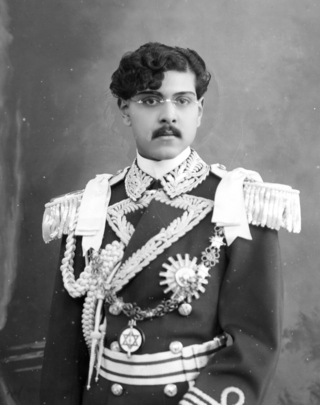
Tribhuvan Bir Bikram Shah Dev, was King of Nepal. Born in Kathmandu, the capital city of Nepal, he ascended to the throne at the age of five, upon the death of his father, Prithvi Bir Bikram Shah, and was crowned on 20 February 1913 at the Nasal Chowk, Hanuman Dhoka Palace in Kathmandu, with his mother acting as regent. At the time of his crowning, the position of monarch was largely ceremonial, with the real governing power residing with the Rana family.

Chhetri, historically called Kshettriya or Kshetriya or Khas are Nepali speaking Rajputs historically associated with the warrior class and administration, some of whom trace their origin to migration from medieval India. Chhetri was a caste of administrators, governors, warriors and military elites in the medieval Khas Kingdom and Gorkha Kingdom. The nobility of the Gorkha Kingdom mainly originated from Chhetri families. They also had a strong presence in civil administration affairs. The bulk of prime ministers of Nepal before the democratization of Nepal belonged to this caste as a result of the old Gorkhali aristocracy. Gorkha-based aristocratic Chhetri families included the Pande dynasty, the Basnyat dynasty, the Kunwar family and the Thapa dynasty.
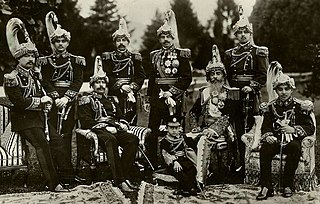
The Rana dynasty was a Chhetri dynasty that imposed authoritarianism in the Kingdom of Nepal from 1846 until 1951, reducing the Shah monarch to a figurehead and making the Prime Minister and other government positions held by the Ranas hereditary. The Rana dynasty is historically known for their iron-fisted rule in Nepal. This changed after the Revolution of 1951 with the promulgation of a new constitution, when power shifted back to the monarchy of King Tribhuvan.

Subarna Shamsher Rana was a leading figure in the movement to overthrow the ruling Rana oligarchy and to establish democracy in Nepal. He was one of the three leaders of the Nepali Congress in the late 1940s, opposing his relatives, the Rana family, who held power in Nepal at the time.
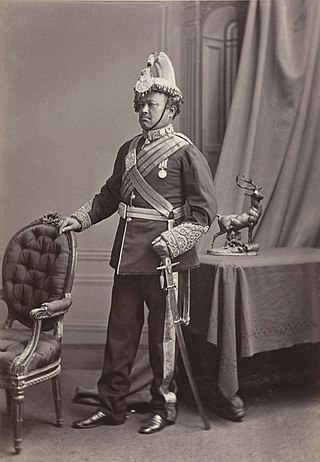
Ranaudip Singh Bahadur Kunwar Ranaji, KCSI, commonly known as Ranodip Singh Kunwar was the second Prime Minister of Nepal from the Rana dynasty. His style was His Excellency Commanding General Shree Shree Shree Maharaja Sir.
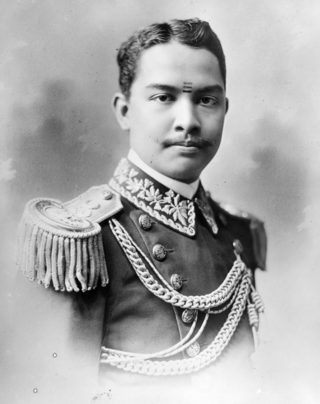
Field Marshal Sir Kaiser Shumsher Jang Bahadur Rana, GBE was a field marshal in the Royal Nepalese Army. He was the third son of Maharaja Sir Chandra Shamsher Jang Bahadur Rana, GCB, GCSI, GCMG, GCVO the fifth Prime Minister of Nepal of the Rana dynasty and Bada Maharani Chandra Loka Bhaktha Rajya Lakshmi.
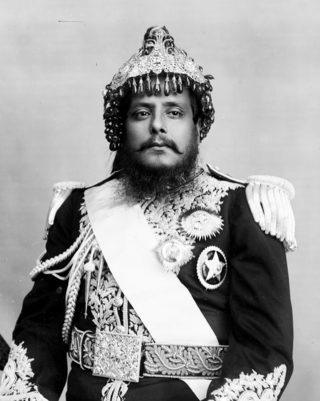
Commanding General Shree Maharaja Sir Bir Shumsher Jung Bahadur Rana was the 11th Prime Minister of Nepal. He is remembered as a statesman who made reforms and infrastructure improvements. Bir Shamsher Jung Bahadur Rana was known as Kailay in his childhood; this name was given by Jung Bahadur. His mother was daughter of Pahalman Singh Basnyat and sister of Lalitman Singh Basnyat. His mother died at his birth and he was taken care of by Putali Maharani, wife of Jung Bahadur. He spent his childhood at Thapathali Durbar.

Sir Baber Shumsher Jung Bahadur Rana, GCVO, GBE, KCSI, KCIE was a member of the Rana dynasty who served as the Minister of Defence of Nepal in 1951. A prominent member of the Rana oligarchy, he fought valiantly in the First World War. He was the second son of Maharaja Sir Chandra Shamsher Jang Bahadur Rana and Bada Maharani Chandra Loka Bhakta Lakshmi Devi. He was the younger brother of Maharaja Sir Mohan Shamsher Jang Bahadur Rana and older brother of Field Marshal Sir Kaiser Shamsher Jang Bahadur Rana.
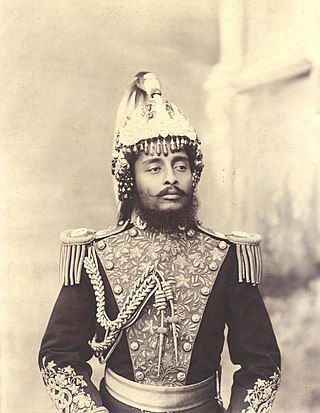
Field-Marshal His Highness Maharaja Sri Teen Chandra Shumsher Jung Bahadur Rana was the Prime Minister of Nepal from the Rana dynasty. He served in this capacity from 27 June 1901 to his death in 1929 after he successfully deposed his liberal and reformist brother Dev Shamsher. Although generally perceived as despotic and conservative, he is credited with several reforms including the abolition of slavery and establishing the Nepal-Britain Treaty of 1923, which recognised Nepal as an independent nation and an ally of Britain.

Kunwar is an Indian title denoting a prince. It is derived from the Sanskrit word Kumar. It was traditionally associated with the feudal Rajputs such as the son of a Rana, Babu and Thakur
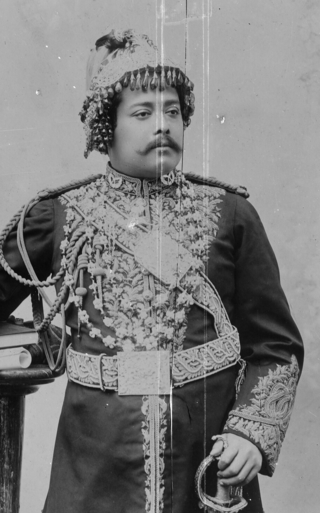
Sri Maharaja, Dev Shumsher Jung Bahadur Rana was the Prime Minister of Nepal for 114 days in 1901. He was also the King of Lamjung and Kaski.
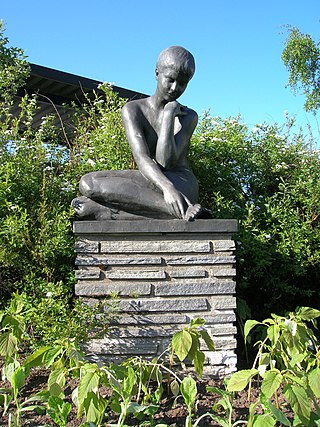
Rana is a given name and surname of multiple origins.

The revolution of 1951 in Nepal, also referred to as Sat Salko Kranti, was a political movement against the direct rule by the Rana dynasty of Nepal which had lasted for 104 years. It marks the beginning of the political awakening and democratic movements in Nepal, and resulted in immediate abolition of the institutionalized hereditary Prime Minister system in Nepal.

Pashupati Shumsher Jung Bahadur Rana is a politician from the Rana dynasty. He served in the Ministry of Foreign Affairs, the Ministry of Finance, the Ministry of Water Resources and Communication (1990–1994), Minister of Water Resources after the Panchayat era. He served as Minister of Panchayat and Local Development (1986–1988), Ministry of Transport and Tourism (1978–1979) and various other full ministers and state ministers during the Panchayat era. He is also one of the richest people in Nepal.

Dhir Shumsher Kunwar, after 1848 known as Dhir Shumsher Kunwar Ranaji or Dhir Shumsher Jang Kunwar Ranaji or shortly Dhir Shumsher Rana posthumously known as Dhir Shumsher Jang Bahadur Rana, was a Nepalese politician, army general, and minister of state. He served as the Commander-In-Chief of the Nepalese Army from 1879 to 1884.

Jagat Jung Kunwar Rana, popularly known as Jagat Jung Rana was a Nepalese politician, military officer and courtier in the Kingdom of Nepal. He was the eldest son of the founder of Rana dynasty, Jung Bahadur Kunwar Rana. He claimed the Premiership of Kingdom of Nepal and the throne of Maharaja of Lamjung and Kaski against the traditional agnatic succession of the Rana dynasty. Driven by this motive, he attempted a coup against his uncles; Maharaja Prime Minister Ranodip Singh Kunwar and Commander-In-Chief Dhir Shamsher Kunwar Rana in the winter of 1881–1882. He was immediately thrown out of the roles of succession among Ranas. Later, he was pardoned and was impeased by Ranodip Singh as his successor after the death of Dhir Shamsher, which caused envy among his Shamsher cousins and ultimately led to his death in the 1885 Shamsher coup.

Commanding-General His Highness RajaKhadga Shamsher Jang Bahadur Rana or Khadga Shamsher Jang Bahadur Kunwar Rana previously known as Khadga Shamsher Kunwar Rana was Nepalese politician, military general, governor and courtier in the Kingdom of Nepal. He was born in the Rana dynasty as third son of Commander-In-Chief of the Nepalese Army Dhir Shamsher Kunwar Rana. He was influential in the family coup of 1885 that led to the political rise of his Shamsher faction through the murders of then ruling Prime Minister of Nepal and his uncle Maharaja Ranodip Singh Kunwar, Ranodip's favourite nephew and would-be-successor Jagat Jang Rana and his other politically rival non-Shamsher cousins. In the aftermath of the coup, he secured the position of the Commander-In-Chief of the Nepalese Army and was second-in-line to Prime Minister Maharaja Bir Shamsher Jang Bahadur Rana before he was removed out of the roll of the succession of Ranas in 1887. Afterwards, he served as Governor of Palpa and constructed the renowned Rani Mahal. In December 1896, he together with German archaeologist Dr. Alois Anton Führer discovered the Lumbini pillar inscription of Ashoka that proved Gautam Buddha's birthplace as Lumbini.
Lamjung and Kaski was a state which was given to His Highness Shree Tin Maharaja Jung Bahadur Rana in 1856 by His Majesty King Surendra Bir Bikram Shah.
Shumsher is a given name popular in Nepal, and was carried by most of the Rana dynasty. Notable people with the surname include: